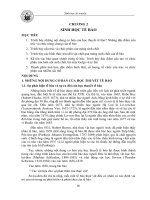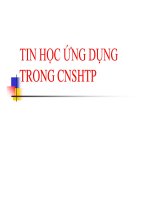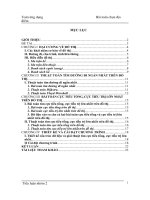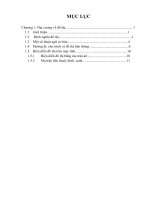Tin học ứng dụng trong công nghệ hóa học Parallelprocessing 10 parallel paradigm programming model
Bạn đang xem bản rút gọn của tài liệu. Xem và tải ngay bản đầy đủ của tài liệu tại đây (380.8 KB, 28 trang )
Parallel Paradigms
&
Programming Models
Thoai Nam
Outline
Parallel
programming paradigms
Programmability Issues
Parallel programming models
–
–
–
Implicit parallelism
Explicit parallel models
Other programming models
Khoa Khoa học và Kỹ thuật Máy tính - Đại học Bách Khoa TP.HCM
-2-
Parallel Programming
Paradigms
Parallel programming paradigms/models are the
ways to
–
–
–
Design a parallel program
Structure the algorithm of a parallel program
Deploy/run the program on a parallel computer system
Commonly-used algorithmic paradigms
–
–
–
–
–
–
Phase parallel
Synchronous and asynchronous iteration
Divide and conquer
Pipeline
Process farm
Work pool
Khoa Khoa học và Kỹ thuật Máy tính - Đại học Bách Khoa TP.HCM
-3-
Parallel Programmability
Issues
The programmability of a parallel programming
models is
–
–
How much easy to use this system for developing and
deploying parallel programs
How much the system supports for various parallel
algorithmic paradigms
Programmability is the combination of
–
–
–
Structuredness
Generality
Portability
Khoa Khoa học và Kỹ thuật Máy tính - Đại học Bách Khoa TP.HCM
-4-
Structuredness
A program is structured if it is comprised of
structured constructs each of which has these 3
properties
–
–
–
Is a single-entry, single-exit construct
Different semantic entities are clearly identified
Related operations are enclosed in one construct
The structuredness mostly depends on
–
–
The programming language
The design of the program
Khoa Khoa học và Kỹ thuật Máy tính - Đại học Bách Khoa TP.HCM
-5-
Generality
A program class C is as general as or more general
than program class D if:
–
–
–
For any program Q in D, we can write a program P in C
Both P & Q have the same semantics
P performs as well as or better than Q
Khoa Khoa học và Kỹ thuật Máy tính - Đại học Bách Khoa TP.HCM
-6-
Portability
A program is portable across a set of computer
system if it can be transferred from one machine
to another with little effort
Portability largely depends on
–
–
The language of the program
The target machine’s architecture
Levels of portability
1.
2.
3.
4.
Users must change the program’s algorithm
Only have to change the source code
Only have to recompile and relink the program
Can use the executable directly
Khoa Khoa học và Kỹ thuật Máy tính - Đại học Bách Khoa TP.HCM
-7-
Parallel Programming Models
Widely-accepted programming models are
–
–
–
–
Implicit parallelism
Data-parallel model
Message-passing model
Shared-variable model ( Shared Address Space model)
Khoa Khoa học và Kỹ thuật Máy tính - Đại học Bách Khoa TP.HCM
-8-
Implicit Parallelism
The compiler and the run-time support system
automatically exploit the parallelism from the
sequential-like program written by users
Ways to implement implicit parallelism
–
–
–
Parallelizing Compilers
User directions
Run-time parallelization
Khoa Khoa học và Kỹ thuật Máy tính - Đại học Bách Khoa TP.HCM
-9-
Parallelizing Compiler
A parallelizing (restructuring) compiler must
–
–
Performs dependence analysis on a sequential
program’s source code
Uses transformation techniques to convert sequential
code into native parallel code
Dependence analysis is the identifying of
–
–
Data dependence
Control dependence
Khoa Khoa học và Kỹ thuật Máy tính - Đại học Bách Khoa TP.HCM
-10-
Parallelizing Compiler(cont’d)
Data dependence
X =
X +
1
Y =
X +
Y
Control dependence
If f(X) = 1 then
Y = Y + Z;
When dependencies do exist, transformation
techniques/ optimizing techniques should be used
–
–
To eliminate those dependencies or
To make the code parallelizable, if possible
Khoa Khoa học và Kỹ thuật Máy tính - Đại học Bách Khoa TP.HCM
-11-
Some Optimizing Techniques for
Eliminating Data Dependencies
Privatization technique
Do i=1,N
ParDo i=1,N
P:
A
= …
Q:
X(i)= A + …
…
End Do
Q needs the value A of
P, so N iterations of the
Do loop can not be
parallelized
P:
A(i) = …
Q:
X(i) = A(i) + …
…
End Do
Each iteration of the Do loop
have a private copy A(i), so
we can execute the Do loop in
parallel
Khoa Khoa học và Kỹ thuật Máy tính - Đại học Bách Khoa TP.HCM
-12-
Some Optimizing Techniques for
Eliminating Data Dependencies(cont’d)
Reduction technique
Do i=1,N
ParDo i=1,N
P:
X(i) = …
P:
X(i) = …
Q:
Sum = Sum + X(i)
Q:
Sum = sum_reduce(X(i))
…
…
End Do
End Do
The Do loop can not be
executed in parallel since the
computing of Sum in the i-th
iteration needs the values of
the previous iteration
A parallel reduction function is used
to avoid data dependency
Khoa Khoa học và Kỹ thuật Máy tính - Đại học Bách Khoa TP.HCM
-13-
User Direction
Users help the compiler in parallelizing by
–
–
Providing additional information to guide the parallelization process
Inserting compiler directives (pragmas) in the source code
User is responsible for ensuring that the code is correct after
parallelization
Example (Convex Exemplar C)
#pragma_CNX loop_parallel
for (i=0; i <1000;i++){
A[i] = foo (B[i], C[i]);
}
Khoa Khoa học và Kỹ thuật Máy tính - Đại học Bách Khoa TP.HCM
-14-
Run-Time Parallelization
Parallelization involves both the compiler and the
run-time system
–
–
Additional construct is used to decompose the sequential
program into multiple tasks and to specify how each task
will access data
The compiler and the run-time system recognize and
exploit parallelism at both the compile time and run-time
Example: Jade language (Stanford Univ.)
–
–
More parallelism can be recognized
Automatically exploit the irregular and dynamic
parallelism
Khoa Khoa học và Kỹ thuật Máy tính - Đại học Bách Khoa TP.HCM
-15-
Conclusion Implicit Parallelism
Advantages of the implicit programming model
–
–
–
Ease of use for users (programmers)
Reusability of old-code and legacy sequential
applications
Faster application development time
Disadvantages
–
–
The implementation of the underlying run-time systems
and parallelizing compilers is so complicated and
requires a lot of research and studies
Research outcome shows that automatic parallelization
is not so efficient (from 4% to 38% of parallel code
written by experienced programmers)
Khoa Khoa học và Kỹ thuật Máy tính - Đại học Bách Khoa TP.HCM
-16-
Explicit Programming Models
Data-Parallel
Message-Passing
Shared-Variable
Khoa Khoa học và Kỹ thuật Máy tính - Đại học Bách Khoa TP.HCM
-17-
Data-Parallel Model
Applies to either SIMD or SPMD modes
The same instruction or program segment executes
over different data sets simultaneously
Massive parallelism is exploited at data set level
Has a single thread of control
Has a global naming space
Applies loosely synchronous operation
Khoa Khoa học và Kỹ thuật Máy tính - Đại học Bách Khoa TP.HCM
-18-
Data-Parallel: An Example
Example: a data-parallel program
to compute the constant “pi”
main() {
double local[N], tmp[N], pi, w;
long i, j, t, N=100000;
A: w=1.0/N;
B: forall(i=0; i
Data-parallel operations
Q: tmp[i]=4.0/(1.0+local[i]*local[i]);
}
Reduction operation
C: pi=sum(tmp);
D: printf(“pi is %f\n”, pi*w);
} //end main
Khoa Khoa học và Kỹ thuật Máy tính - Đại học Bách Khoa TP.HCM
-19-
Message-Passing Model
Multithreading: program consists of multiple
processes
–
–
Asynchronous Parallelism
–
–
Each process has its own thread of control
Both control parallelism (MPMD) and data parallelism
(SPMD) are supported
All process execute asynchronously
Must use special operation to synchronize processes
Multiple Address Spaces
–
–
Data variables in one process is invisible to the others
Processes interact by sending/receiving messages
Khoa Khoa học và Kỹ thuật Máy tính - Đại học Bách Khoa TP.HCM
-20-









